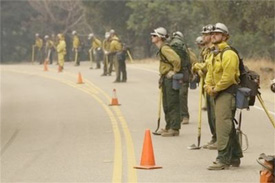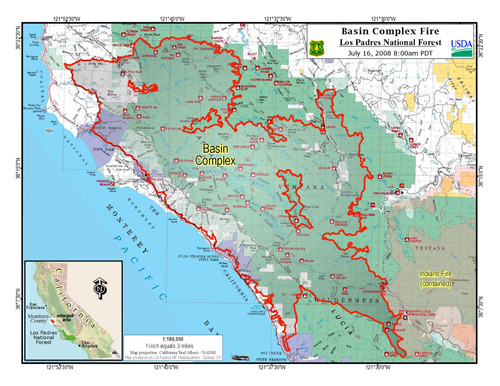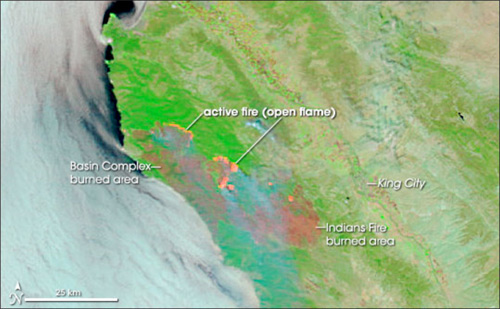
A series of record-breaking wildfires burned through Big Sur during the summer of 2008. The Indians Fire began on June 8th and was ignited by a campfire, while the Basin Complex Fire was ignited by lightning on June 21st, and merged with the Indians Fire by June 25th. The merged fire was finally contained on July 27th at a total containment cost of $120 million, making it the most expensive fire in California history, and 2nd most expensive in U.S. History (W.I.S.E., 2008). About 240,00 acres of federal, state, and private lands – 83% of which was a part of the Monterey District of the Los Padres National Forest – burned in the fire. The fire extended south to Fort Hunter Liggett and north to Carmel Valley, creating a footprint 40 miles north-south and 15 miles east-west. In several areas, the fire burned to the edge of Highway 1, forcing evacuations of homes and businesses, as well as road and park closures (U.S.F.S., 2008).
A Burned Area Emergency Response (BAER) team comprised of US Forest Service personnel met in August 2008 to assess the aftermath. The purpose of the BAER team is to “identify potential threats to life, property and infrastructures along with potential threats to water quality and recreational resources, wildlife, vegetation, fisheries and cultural resources.” The early findings of the assessment conclude that the natural vegetation may take up to 3 years to re-colonize. Until the area becomes re-vegetated, the BAER team asserts that residents and business located in the watersheds affected by the fire are at risk due to debris flow, mudslides, and floods during the winter season (U.S.F.S., 2008).
It is important to understand that wildfires are a natural and necessary part of the coastal ecosystem in California, and fires are also essential tools in resource management (Ainsworth et al., 1995). However, large fires like the Indians and Basin Complex fires are indeed rare and very costly. While the direct effects of wildfires are evident, the indirect impacts of wildfires will be felt in the Monterey Bay National Marine Sanctuary. Runoff from rain will wash debris from the fire into the ocean, and could have detrimental effects on nearshore marine communities. Research and monitoring projects are in place throughout the Sanctuary to track terrestrial inputs from the fires and determine if it alters water chemistry, quality, and clarity, as well as measure community-level responses in the rocky intertidal and adjacent kelp forests.


|